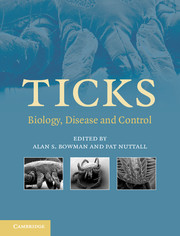Book contents
- Frontmatter
- Contents
- List of contributors
- Preface
- 1 Systematics and evolution of ticks with a list of valid genus and species names
- 2 The impact of tick ecology on pathogen transmission dynamics
- 3 Tick salivary glands: the physiology of tick water balance and their role in pathogen trafficking and transmission
- 4 Tick saliva: from pharmacology and biochemistry to transcriptome analysis and functional genomics
- 5 Tick toxins: perspectives on paralysis and other forms of toxicoses caused by ticks
- 6 Tick lectins and fibrinogen-related proteins
- 7 Endocrinology of tick development and reproduction
- 8 Factors that determine sperm precedence in ticks, spiders and insects: a comparative study
- 9 Tick immunobiology
- 10 Saliva-assisted transmission of tick-borne pathogens
- 11 Lyme borreliosis in Europe and North America
- 12 Viruses transmitted by ticks
- 13 Babesiosis of cattle
- 14 Theileria: life cycle stages associated with the ixodid tick vector
- 15 Characterization of the tick–pathogen–host interface of the tick-borne rickettsia Anaplasma marginale
- 16 Emerging and emergent tick-borne infections
- 17 Analysing and predicting the occurrence of ticks and tick-borne diseases using GIS
- 18 Acaricides for controlling ticks on cattle and the problem of acaricide resistance
- 19 Anti-tick vaccines
- 20 Anti-tick biological control agents: assessment and future perspectives
- 21 Pheromones and other semiochemicals of ticks and their use in tick control
- Index
- References
4 - Tick saliva: from pharmacology and biochemistry to transcriptome analysis and functional genomics
Published online by Cambridge University Press: 21 August 2009
- Frontmatter
- Contents
- List of contributors
- Preface
- 1 Systematics and evolution of ticks with a list of valid genus and species names
- 2 The impact of tick ecology on pathogen transmission dynamics
- 3 Tick salivary glands: the physiology of tick water balance and their role in pathogen trafficking and transmission
- 4 Tick saliva: from pharmacology and biochemistry to transcriptome analysis and functional genomics
- 5 Tick toxins: perspectives on paralysis and other forms of toxicoses caused by ticks
- 6 Tick lectins and fibrinogen-related proteins
- 7 Endocrinology of tick development and reproduction
- 8 Factors that determine sperm precedence in ticks, spiders and insects: a comparative study
- 9 Tick immunobiology
- 10 Saliva-assisted transmission of tick-borne pathogens
- 11 Lyme borreliosis in Europe and North America
- 12 Viruses transmitted by ticks
- 13 Babesiosis of cattle
- 14 Theileria: life cycle stages associated with the ixodid tick vector
- 15 Characterization of the tick–pathogen–host interface of the tick-borne rickettsia Anaplasma marginale
- 16 Emerging and emergent tick-borne infections
- 17 Analysing and predicting the occurrence of ticks and tick-borne diseases using GIS
- 18 Acaricides for controlling ticks on cattle and the problem of acaricide resistance
- 19 Anti-tick vaccines
- 20 Anti-tick biological control agents: assessment and future perspectives
- 21 Pheromones and other semiochemicals of ticks and their use in tick control
- Index
- References
Summary
INTRODUCTION
When a tick attaches to a mammalian host to obtain a blood meal it must counteract the well developed haemostatic, inflammatory and immune systems which function to avoid blood loss and to reject unwanted guests. Ticks have been in the blood-feeding business for millions of years and have acquired potent pharmacologically active molecules found in their saliva that can disarm and counteract the haemostatic system of the mammalian host (Ribeiro, 1987b, 1995) and alter the host inflammatory and immune responses (Gillespie et al., 2000; Wikel, 1999). The types of molecules present in tick saliva range from lipids to small peptides and large proteins; each is capable of altering the physiology of the feeding site, consequently affecting pathogen transmission (Ribeiro, 1995; Valenzuela, 2002b; see also Chapter 10). Adaptation of ticks to their natural hosts resulted in the ability of ticks to modulate host immune and haemostatic responses with their saliva. However, tick feeding on non-natural hosts often results in an immune and allergic response, presumably to the injected salivary proteins, resulting in tick rejection (Ribeiro, 1989). Furthermore, in some cases, an immune response to tick feeding confers protection against the pathogens ticks transmit.
Because of the importance of tick saliva, there is increasing interest in the identification and isolation of the molecules in saliva responsible for these effects. The small amount of protein and other biological material present in tick salivary glands has made this a difficult task for many years.
Information
- Type
- Chapter
- Information
- TicksBiology, Disease and Control, pp. 92 - 107Publisher: Cambridge University PressPrint publication year: 2008
References
Accessibility standard: Unknown
Why this information is here
This section outlines the accessibility features of this content - including support for screen readers, full keyboard navigation and high-contrast display options. This may not be relevant for you.Accessibility Information
- 6
- Cited by
